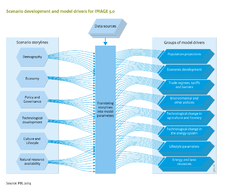Drivers/Policy issues: Difference between revisions
< Drivers
Jump to navigation
Jump to search
No edit summary |
No edit summary |
||
| Line 14: | Line 14: | ||
As mentioned, different models were used by teams at different institutes, allowing to investigate how different model structures and assumptions, but also different interpretations of the qualitative scenario story lines in model parameters, lead to quite different results (Figure 3.3c***). The projections for the SSP3 scenario not only differ with respect to the level in 2100, but also in the pathway over the century. | As mentioned, different models were used by teams at different institutes, allowing to investigate how different model structures and assumptions, but also different interpretations of the qualitative scenario story lines in model parameters, lead to quite different results (Figure 3.3c***). The projections for the SSP3 scenario not only differ with respect to the level in 2100, but also in the pathway over the century. | ||
===Baseline and policy interventions in | ===Baseline and policy interventions in the framework=== | ||
For more information on how Baseline scenarios play out in more detail in economic, social and ecological terms, see the results per component of the IMAGE 3.0 framework in the 'policy issue' pages of the component. | For more information on how Baseline scenarios play out in more detail in economic, social and ecological terms, see the results per component of the IMAGE 3.0 framework in the 'policy issue' pages of the component. | ||
Once Baseline scenarios are implemented, modifications at various levels can be made that reflect policy interventions aiming to diverge from the trends emerging under baseline conditions. This can take many different shapes and forms, depending on the subject, scale, timeframe and policy levers under consideration. Reducing climate change impacts is one obvious example, but also reducing nutrient loading of coastal sees, slowing down the rate of biodiversity loss, reducing water stress, and many other options to alleviate anticipated future problems have been explored with IMAGE during the last decade. Again, for more information on policies, instruments and goals pursued, see the individual components (framework overview). | Once Baseline scenarios are implemented, modifications at various levels can be made that reflect policy interventions aiming to diverge from the trends emerging under baseline conditions. This can take many different shapes and forms, depending on the subject, scale, timeframe and policy levers under consideration. Reducing climate change impacts is one obvious example, but also reducing nutrient loading of coastal sees, slowing down the rate of biodiversity loss, reducing water stress, and many other options to alleviate anticipated future problems have been explored with IMAGE during the last decade. Again, for more information on policies, instruments and goals pursued, see the individual components (framework overview). | ||
}} | }} | ||
Revision as of 15:54, 11 December 2013
Parts of Drivers/Policy issues
| Projects/Applications |
| Models/Databases |
| Relevant overviews |
| Key publications |
| References |
